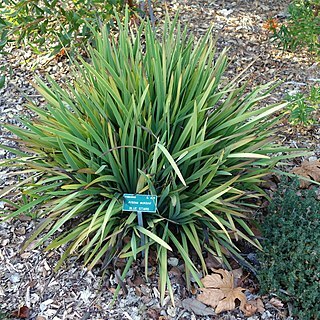Plants mostly 350-600 mm high. Stem compressed, 2-winged, usually several-branched and with sessile axillary flower clusters in upper axils subtended by short, sometimes bract-like leaves, when dry often turning rusty brown. Leaves sword-shaped, mostly 8-15 mm wide, soft-textured, mostly basal, cauline leaves shorter. Flower clusters several in lax arrangement, each mostly 4-flowered; spathes green with dry margins or completely dry and rust-brown, ± 10 mm long, bracts papery, rusty brown, shorter than spathes. Flowers deep blue; tepals elliptic, mostly 8-10 mm long. Filaments ± 4 mm long; anthers ± 2.5 mm long. Style short, erect, ± 5 mm long, broadly lobed apically. Capsules oblong-elongate, deeply 3-lobed, 12-20 mm long, on pedicels up to 4 mm long. Seeds shortly columnar, sculpturing reticulate, many per locule lying in a single vertical row.
Leaves to 40 cm long, ± 1 cm wide, < scape, equitant, in a reddish-purple based fan. Scapes to 45 cm high, compressed, slightly winged. Lower spathe-valves and all bracteoles membranous, reddish-brown. Flowers in numerous 5-7-flowered clusters in a loose elongate panicle, very fragile, opening for a few hours in bright sunlight only; perianth ± 12 mm long, ± 2 cm diam., lobes deep blue, tube very short, green. Capsule 2 cm long, oblong or cylindrical, valves with a deep median groove. Seeds c. 1.5 × 1.5 mm, dark red-brown, angular-compressed, surface reticulate.
Perennial, rhizomatous herb, 0.15-0.70 m high, grows in clumps; stem branched, usually winged. Leaves lanceolate-apiculate, basal longer than cauline ones, usually exceeding length of stem. Spathes green with dry margins. Bracts scarious, rust-coloured, margins entire, hyaline. Inflorescence a terminal or axillary panicle, usually (2-)4-flowered; flowers blue, stalked or ± sessile in axils; tepals obovate. Ovary triangular; style 4.5 mm long, reaching middle of anthers, 3-lobed. Flowering time July-May. Capsule extremely oblong.
Flower clusters several to many, both terminal and axillary, stalked or more or less sessile in the axils, each usually (2)4-flowered; spathes scarious and rust-coloured with herbaceous keels, 13–16 mm long; floral bracts entirely scarious, c. 10 mm long, the margins entire.
Leaves several, basal and cauline, the lower leaves longest and exceeding the stem in length, 5–9 mm wide, narrowly lanceolate, progressively reduced in size above, those subtending the axillary flower clusters 2–5 cm long and exceeding the spathes and bracts.
Perennial herb, up to 0.9 m high. Capsule oblong, 10-26 x 3.5-5.0 mm. Inflorescence usually paniculately branched. Bracts and bracteoles scarious, green and rusty-brown. Flowers pale blue to deep blue and mauve.
Rhizomatous perennial to 50 cm, stem 2-winged, usually much branched. Leaves broad, sword-shaped, soft. Flowers deep blue, spathes scarious, brownish. Capsules oblong, 3-lobed.
Capsules 12–18 mm long, cylindric-trigonous, on pedicels 6–10 mm long.
Stem elliptic in section, usually winged, few-to several-branched.
Style c. 4.5 mm long, reaching the middle of the anthers, 3-lobed.
Filaments c. 4 mm long, anthers c. 2 mm long.
Flowers blue, on pedicels c. 5 mm long.
Tepals 8–10 × c. 4 mm, obovate.
Plants 40–60 cm high.
In clumps 2 ft. high
Pending.

